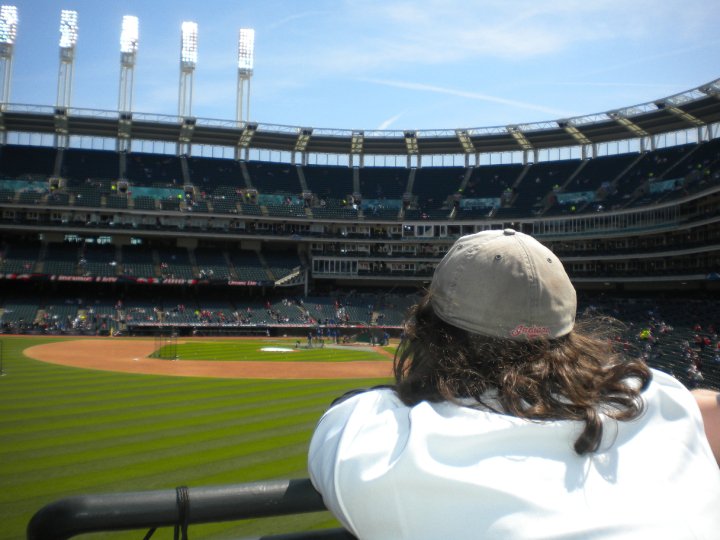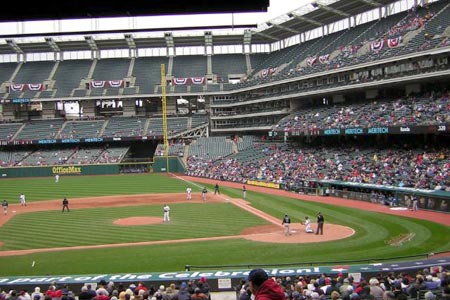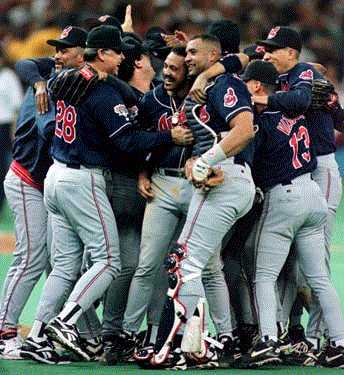 Indians Archive
Indians Archive  View from the Porch: 200 Days Edition
View from the Porch: 200 Days Edition
 This week, as the majority of teams limped to the finish line and the usual suspects battled for playoff positioning, the Indians released their 2012 schedule. With not a whole lot to talk about from the field (the Indians have lost 8 of 10), let’s look ahead to next year.
This week, as the majority of teams limped to the finish line and the usual suspects battled for playoff positioning, the Indians released their 2012 schedule. With not a whole lot to talk about from the field (the Indians have lost 8 of 10), let’s look ahead to next year.
Certainly, this offseason is big for the Tribe as they set the message that their contention window is right now. I, and others on TCF, have outlined the holes that the team has and will look at possible plugs for those holes in a future column. But, for now, all we have to do is count down the days to 2012 Opening Day (by the way, it is 200 days from today, 9/17).
I like to breakdown the schedule when it comes out every year and look at where the schedule makers screwed us over and where they made moronic decisions. Voice of the Indians Tom Hamilton likes to joke that the schedule makers are all drunk when they produce the April-September/October calendar for the season. He’s probably right.
April: For the second straight season, the Indians begin a new season at home. The Toronto Blue Jays will be in town for an opening three-game set beginning Thursday April 5, with an off day on Friday and then a couple weekend affairs. First of all, as we all know here in NE Ohio, April weather is not easy to predict. So, how do we approach that fact? Well, we play a home opener against a team who has a domed stadium. Following this season’s plethora of rainouts, makeup games, and doubleheaders, we start the year against a team who comes to Cleveland all of one time. Perfectly conducive to scheduling makeup games.
I have yet to determine if I think that the Friday off day is a safety blanket for a postponed game on April 5 or if it is a calculated move to take a Good Friday game out of the equation. Either way, the Indians open the season at home on Easter Weekend.
In a potential stroke of genius, April has five off days for the Indians. I have not checked to see if this is a league-wide phenomenon, though two of the off days bookend a west coast trip.
April is a much less difficult month than May and I’m a big fan of west coast trips early in the season. They allow newcomers on the team to gel with guys who have been here. They give the team a chance to play in some decent weather. I have very few qualms with the April schedule except for the inexplicable opening series against a team who plays in a dome and is a rescheduling nightmare.
May: Remember those five off days the Indians get in April? Starting May 1, the team will play 29 games in 30 days, barring any rainouts/doubleheaders. May will feature nine games against the hated Chicago White Sox. Adding that to the three games in April, the Indians will have played two-thirds of their games against that Central Division foe by the end of May. Comparatively, they will have played 6/18 v. KC, 3/18 v. DET, and 2/18 against MIN. The final six against Chicago will be played the last week of the season, including a year-ending three-game set at the Jake.
Here’s my problem with that. I like having Chicago out of the way because we tend to perennially suck against them and approximately 250% of their lineup murders Indians pitching. With the unbalanced divisional schedule, one would think that the games would be a little bit more spread out. Evidently not when it comes to the White Sox.
Regardless, the biggest head scratcher of May is a two-game home series from May 16-17. I really don’t see a whole lot of value to two-game series. This home twin-pack follows a two-gamer in Minnesota. It is against....the Seattle Mariners. Seriously? The northernmost pacific team in for a TWO-game series? This must be Major League Baseball’s version of a knock-knock joke. Intended to be funny, but instead just irritatingly stupid.
I notice that there’s a “MIA” on the schedule this year. I must say, I really have to like how the Florida Marlins are changing their name so that their team abbreviation can be representative of the fan base. Nothing says Miami baseball like MIA fans. Crafty move.
May also features the first of two four-game series with the Boston Red Sox. Based on the Indians play within the Central Division, series with Boston and Texas and the 29 games in 30 days, this looks to be the team’s second hardest month of the season.
June: Ah, June. Sweet, sweet June. The sun shows itself regularly, the kids are done with school, and the Indians begin to draw better crowds thanks to the nice weather and allure of spending a night outside. Major League Baseball really caters to the small markets when it comes to their attendance figures.

That’s why the Indians have nine home games in June. Nine at home and a whopping 18 on the road. I don’t claim to be a genius, but, wouldn’t it behoove Major League Baseball to try and close the gaping attendance gaps by granting smaller market teams some marquee matchups during the months where attendance might actually be decent? Apparently not.
The Indians do play interleague opponents Pittsburgh and Cincinnati, which lends itself well to fans from those two cities who make the trek to Cleveland. Of course, the Cincinnati series is a Monday-Wednesday, much like the Indians trip to the Kentucky border is a midweek Tuesday-Thursday affair. Good looking out by Major League Baseball there. Nothing says four hour roadtrip like the middle of the work week.
In terms of interleague travel, the Indians will head to St. Louis, Cincinnati, and Houston.
The Wahoos will end the month by heading to the Bronx and Baltimore to fulfill their one trip per season obligation.
July: In a recurring theme, the Indians will play Tampa Bay yet again in this July, this time, in two separate four-game series. As of the All-Star Break, the Indians will have played 45 of 81 home games and 40 of 81 road games. From June to the final week of August, the Indians will have 33 of their 81 home games. So, during the time when attendance is likely to be at its peak, the Indians have just 41% of their home dates. Thanks MLB. We appreciate it.
July is a mixed bag with the Indians facing a team from each division and playing Tampa Bay eight times. Leading up to the trade deadline, the Tribe will play 18 games in 19 days. Including one series at home against Detroit, it could provide a good barometer for what the team will do at the deadline, assuming they have gotten off to a competitive start for the first three months of the season.
The Indians will finish one four-game series and play three other full four-gamers in July.
August: As crunch time hits, the Indians get to host Boston, New York, and Texas and take a west coast road trip. Again, thank you MLB. August features far and away the toughest homestand to end the month with New York for three, Oakland for four, and a three-gamer with Texas that carries over in to September.
If nothing else, August will be a tremendous measuring stick one way or another. The schedule is very difficult and the pressure could be on. If the team is in the hunt, we will get a good read on them. If they aren’t, we’ll see how close we really are.
August appears to be the hardest month of the season. The Indians will face a lot of good arms and solid bullpens as well as some pretty talented lineups.
 September/October: Par for the course continues as the final month of the season is jampacked with interdivision games. With the exception of five against Texas, who blasts us every September it seems, the Indians will play 24 games against the Central Division. Exactly six games against each of the four other teams in the division. The Indians final 12 games will come against Kansas City and Chicago, with the final six being at home.
September/October: Par for the course continues as the final month of the season is jampacked with interdivision games. With the exception of five against Texas, who blasts us every September it seems, the Indians will play 24 games against the Central Division. Exactly six games against each of the four other teams in the division. The Indians final 12 games will come against Kansas City and Chicago, with the final six being at home.
The notion of playing our final 12 games against thorn-in-our-side teams is not very comforting, but 12 of the Tribe’s final 18 are at home, where they play significantly better against the Central.
Breakdown of Home/Road by Month
April: 12/9
May: 17/12
June: 9/18
July: 14/12
August: 15/14
September: 11/16
October: 3/0
Overall, this is one of the best schedules that Major League Baseball has put together for the Indians in some time. Obviously, there are issues with it, especially the June home/road disparity and the absurdity of opening the season against a team that only comes to town once, but it is a fairly balanced schedule and has no glaring hindrances. One issue with this past year’s schedule is that the Indians had nine consecutive road interleague games where the services of Travis Hafner were unavailable. That does not happen in 2012.
The Indians do open and close the season at home, something that they have not done since 1993. Hopefully they don’t finish 19 games out like they did in ’93.
Find a printable pdf of the schedule here.
- NBA Announces 2013-2014 Schedule
- Browns Ink Sharknado
- Sharknado A No-Show For Rookie Camp
- Trent Richardson Out Until Training Camp
- Browns Sign Brandon Jackson
- Carrasco Suspended Eight Games
- Browns Add to Wide Receiver Depth with David Nelson
- Browns Need to Learn from Past Draft Mistakes
- Browns Release Chris Gocong and Usama Young
- Browns Missing on Grimes Disappointing, But Not The End
The TCF Forums
- Chris Grant's first 3 drafts
Kingpin74 (Tuesday, January 21 2014 10:13 AM) - The 2014 Offseason Thread
googleeph2 (Tuesday, January 21 2014 9:36 AM) - 2015 Recruiting
furls (Tuesday, January 21 2014 6:57 AM) - Mike Brown
YahooFanChicago (Monday, January 20 2014 11:15 PM) - Movies coming out
HoodooMan (Monday, January 20 2014 9:34 PM) - 2014 Hoops Hockey Hijinx
jpd1224 (Monday, January 20 2014 4:44 PM) - 2014 Recruiting
jclvd_23 (Monday, January 20 2014 2:26 PM) - Wish List - #4 Pick
Hikohadon (Monday, January 20 2014 1:26 PM) - Official- Browns Coach Search/Rumors
OldDawg (Sunday, January 19 2014 6:48 PM) - #1 overall pick Anthony Bennett
TouchEmAllTime (Sunday, January 19 2014 1:28 PM)



